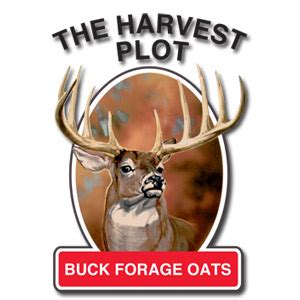What is Buck Forage Oats?

Buck Forage Oats are a type of seed that is commonly used for food plots to attract white-tailed deer and other wildlife. These oats are known for being extremely winter hardy, drought-resistant , and tender. They provide a great fall and winter food source for deer and other wildlife.
Buck Forage Oats are different from other types of oats in that they have been specifically bred and developed to be more palatable to deer. They are designed to produce more tender growth in a food plot for longer periods of time. Buck Forage Oats are also known for being high in protein, which is essential for the growth and development of deer.
These oats can be planted in the fall and can be used for grazing during the winter months. They are also a great option for hunters who want to attract deer to a specific area. Buck Forage Oats can be purchased in bulk, with a 50-pound bag typically being the most common size.
While Buck Forage Oats are a popular choice for food plots, there are other options available as well, such as Winter Rye and Wheat. Imperial Whitetail Oats Plus is another premium oat planting for deer that is known for being cold-tolerant and establishing and growing quickly with high levels of sugar.
Overall , Buck Forage Oats are a great choice for anyone looking to create a successful food plot for white-tailed deer and other wildlife. They are easy to plant and maintain, and provide a great source of nutrition for deer during the fall and winter months.
Frequently Asked Questions about buck forage oats
EverLeaf® Forage Oats are a spring oat developed as a true forage variety. Everleaf Forage Oats will be taller and much leafier than other varieties of oats and produce high levels of dry matter yield if planted for forage production.
Forage oats is the preferred winter forage crop for beef and dairy cattle in Queensland, due to its ability to produce good- quality feed when most pastures are dormant. Many farmers rely on oats to fatten livestock during the period from autumn to early spring.
Plant Buck Forage Oats. For over 30 years, they have been recognized as the highest quality food plot product on the market. Buck Forage Oats are the Top food plot seeds on the USA market.
Oats are highly nutritious as well. In well-managed food plots with a neutral soil pH and good fertility, oats can contain more than 25% crude protein. This rivals any other cool-season forage and is well above the levels required by deer for optimum growth and production. Oats are also highly digestible.
Forage crops are grown specifically for grazing by livestock or harvested to help make up seasonal shortfalls between feed demand and supply. They form a vital part of livestock production.
Buck forage oats is a variety called BOB. Bob is bob, just like ogle is ogle and rockford is rockford. There is a limited variety of winter oats out there on the market. One typically pays $30-40 per 50 lbs of these oats and the result is 1-2 ton of forage per acre.
Forage crops are an essential component of agriculture, providing a reliable and cost-effective source of animal feed. They are also important for sustainable agriculture, as they can help improve soil health and reduce erosion.
Forage oat are typically later maturing and taller. They produce as much as 25% more forage growth than the average certified grain oats. Some of these varieties also contain 5-10% more crude protein. A couple varieties I sell that have tested the best are goliath and forage plus oats.
The crude protein concentration in common legume forages will usually exceed 14% on a dry matter basis. Grasses are usually lower in crude protein than legumes. However, regular application of nitrogen-containing fertilizers to cool-season or warm-season grasses can increase the crude protein content.
Forage. Edible parts of plants, other than separated grain, that can provide feed for grazing animals, or that can be harvested for feeding. Includes browse, herbage, and mast. Browse. Leaf and twig growth of shrubs, woody vines, trees, cacti, and other non-herbaceous vegetation available for animal consumption.
Grain crops may be fed or sold although most forage crops are stored and used on farm for feed. Long term grain producers have seen almost every pest or disease that impacts grain crops and may believe there is nothing new to learn.
There are 8 main forms of oats:
- Whole Oat Groats.
- Steel Cut / Irish Oats.
- Scottish Oats.
- Rolled / Old-Fashioned Oats.
- Quick Oats.
- Instant Oats.
- Oat Bran.
- Oat Flour.
Forage crops are grown specifically for grazing by livestock or harvested to help make up seasonal shortfalls between feed demand and supply. They form a vital part of livestock production.
Fresh forages include grasses and legumes grown in pastures. Ensile plant materials refer to silage and haylage. Forage types vary depending on the needs of animals and the wants of producers. The four forage types are pasture, hay, silage, and haylage.
Both types of oats contain more or less the same amount of nutrients. But if you are looking for a healthier version then steel-cut is better as they are less processed and contain minimum chemicals. If you are particularly trying to shed kilos, steel-cut oats are better as they contain a high amount of fiber.
Historically, the term forage has meant only plants eaten by the animals directly as pasture, crop residue, or immature cereal crops, but it is also used more loosely to include similar plants cut for fodder and carried to the animals, especially as hay or silage.
















